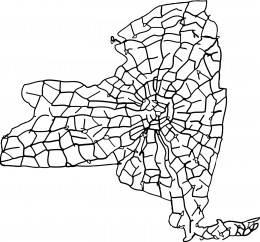
As Nov. 6, 2012 inches ever closer, the country waits to see who will challenge Barack Obama for the U.S. presidency. New York, however, a state that will inevitably be as blue as Papa Smurf come Election Day, has a much more immediate, pressing issue at hand.
When the 2010 Census numbers came out and dictated that New York would lose two congressional seats — down to 27 — it was the state legislature’s job to redraw districts. Democrats and Republicans would lose one seat each, and districts would be set in place well before the 2012 Congressional elections.
Now we have four months until Congressional primaries and New York is one of only a few states who have not yet redrawn their districts, and only one of three who are just “getting started,” according to the blog “All About Redistricting.”
The State Legislature couldn’t get its act together, and now the power is out of its hands. A federal judge in Brooklyn held a hearing yesterday on two separate redistricting plans submitted by state lawmakers.
A post on The New York Times’ “Unmapped” blog indicated that party powerbrokers on both sides managed to agree to tell the judge “to show deference to the legislative proposals and to refrain from drawing districts that would pit incumbent legislators against each other.”
The judge who called for the hearing set a March 12 deadline for state lawmakers who could still pull off an 11th-hour deal. But party politics have seeped too far into the process already — any deal brought forth by New York state legislature will stink of overt gerrymandering and will maintain party strongholds on both sides of the aisle. Gov. Andrew Cuomo should veto any deal.
On the Southern Tier, redistricting is particularly concerning. Binghamton, and the rest of New York’s 22nd District, will see the retirement of 19-year congressman, Maurice Hinchey. Hinchey, a Democratic stalwart who has championed such issues as environmental protection and clean energy, is stepping down due to age and health issues.
While Hinchey emphasized that his retirement had nothing to do with New York’s need to eliminate two districts, it certainly should have made it easier for lawmakers in Albany to decide which Democratic district was getting the axe. Hinchey’s district, which became flanked by Republican districts on all sides after the 2010 midterm elections, should have gotten the “Do Not Resuscitate” order.
But because of the stubbornness in Albany, too many New Yorkers are left without candidates to vote for, and candidates are left without definitive constituents. It is far too close to the election for these kinds of circumstances.
Popular opinion among government watchdog groups in New York is that an independent commission should have been in charge of redrawing districts in the first place, and we agree. In a perfect world, our state legislature wouldn’t even know what the word “gerrymander” means and every election in every Congressional district would be at least nominally competitive.
This late in the game, New York needs to hit the drawing board hard and give voters in disputed territory some semblance of knowledge of their future leaders in a fair, responsible manner.


